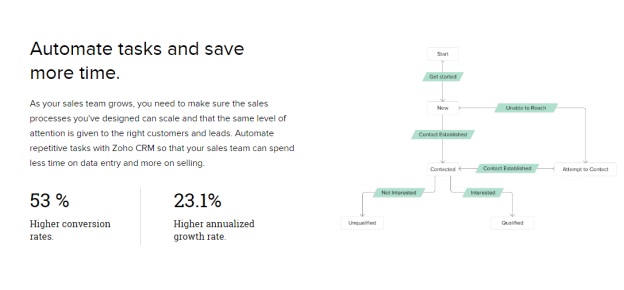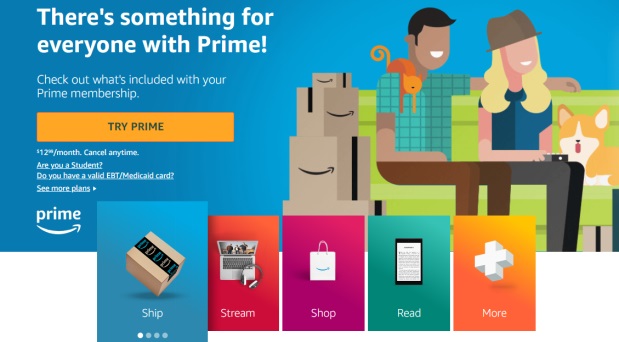Why You Need Specific Content for Each Stage of the Buyer’s Journey

With as many as 81% of consumers conducting research before making a purchase, it’s fair to say that people today have a lot more to say about who they buy from than ever before.
And that’s not necessarily great news for marketers.
Since consumers now have more options to get the products and services they need, it’s important for businesses to keep them engaged throughout the entire buyer’s journey to purchase. One misstep at any stage and you could potentially lose your customer to a competitor.
So, how can you make sure that your buyer’s journey is engaging enough for them to complete it and convert?
With content that’s relevant to them, based on their behavior at each stage.
How Does the Consumer View Your Brand at Each Stage of the Journey?
Although the exact response of each consumer cannot be predicted with complete accuracy, there are ways to predict the general behavior shifts of various customer segments, as they move forward – and deeper – into the sales funnel.
Take, for example, the case of someone looking to buy a smartphone. If the customer is not loyal to any brand in particular, they won’t be inclined to choose a certain model or brand simply because it is popular in the market. Instead, they may well view each smartphone brand equally, and conduct a comprehensive online search for pros and cons of each smartphone model in their budget range.
This part of the customer journey is called the “Awareness” stage, followed by “Consideration” and finally “Purchase”. Let’s go through them one by one:
Journey Stage 1: Awareness
The aim of this stage is to raise brand awareness among consumers who may not yet have formed any solid opinions about their preferred product. Therefore, the trick lies in producing content that’s strictly informative, helpful and educational. By educating the consumer about the features of a smartphone (for example), and what it can actually do for them, it will be possible to lure them into the sales funnel and nurture them as a lead.
Since it’s so early in the buyer’s journey, the chances of conversion are quite low. By creating content that resonates with them now, you can potentially make your brand jump to the top of the list of favorites.
However, don’t confuse this opportunity as a green light to add promotional material into your content at this stage.
Far too many brands today rely on overly promotional content from the get-go in an attempt to convince prospects that they won’t find anything better. Unfortunately for them, many consumers today understand these tricks and techniques.
Most consumers today are likely to be put off by overly promotional content so early in the buyer journey.
By understanding the pain points of your customers and addressing them, you can increase your chances of engaging them with what you have to offer.
Here’s an example of how Zoho does it:

Instead of focusing strictly on the product, Zoho’s landing page is designed with the potential customer in mind. The content of the landing page focuses on the information that prospects might be looking for, as opposed to listing the features of the product.
Once the customer has already conducted initial research and knows which brands suit their needs, they enter into what’s known as the “Consideration” stage.
Journey Stage 2: Consideration
In the Awareness stage, generic and general content is the way to go. In the Consideration stage, you should focus on creating comprehensive, to-the-point and impactful content that compels customers to take action.
During the Consideration stage, the consumer is researching and weighing the options to see which offers the most value. At this point in the journey, the thought processes of your buyers are a lot more focused and centered on specifics. As you might have guessed, this is when you’ll need to start explaining how you can provide a solution.
If you’ve managed to keep your prospect interested in the product or service this far into the journey, well done! But don’t take your eye off the ball now. All of your efforts will go to waste if you don’t know how to keep the consumer hooked long enough to actually convert.
During the Consideration stage, keep your buyer personas at the top of your mind. This way, you can target truly qualified prospects and customers, and filter out the rest.
It’s really important to provide content that is honest, accurate, authentic and value-adding. You don’t want to set up a future scenario where your buyer is disappointed by overreaching claims or promises.
If your buyer has made it this far, they are clearly looking for more information than what they can find in a simple Google search. Dive into more detail and center your content on the problem or challenge at hand. This is the surest way to add value and get results.
Check out the example below of Consideration stage content from Sales Hub: the landing page gives prospects just enough insights about what they can expect in the free white paper, and how it can help them make the right choice when hiring an inbound marketing agency.

During the Consideration stage, you also need to start building a relationship with your buyers and prospects. Since you’ll be a lot more promotional with your content, you can focus on creating personalized and targeted content that puts the buyer at the center.
Journey Stage 3: Purchase
The Purchase stage of the buyer’s journey is characterized by scrutiny. While your buyer is probably excited about making a purchase, it will still take a whole lot of convincing to get that final click. At the same time, it’s important to understand that your buyer has other options available, and they may well still be ready to hear the one excuse not to choose your brand, product or service.
And that’s why exceedingly personalized content is the way to go at this stage.
By building on the relationship that you started creating at the Consideration stage, you can influence the decision of your buyer in favor of your product or service, ultimately convincing them to finally make the purchase. During this stage, you also need to provide a great user experience and solid customer support to close the deal.
While the primary motive behind Purchase-stage content is driving conversions, it’s crucial to solve all the problems and answer all the questions and concerns of your prospects now, to ensure they have no reservations when it comes to making the decision.
Amazon Prime does a great job of this.
Not only is their landing page highly interactive, but the page also provides prospects with extra information they may need to know, via text-based links under the CTA button.

The landing page also has a static bar that invites users to “TRY PRIME” or “See more plans” making it very easy for the potential customer to get more information or click to convert, at any time.
![]()
Using the right visuals, tone, and interactive elements in your Purchase-stage content also helps convince your buyers and makes them feel like they are making the right decision by going ahead with the purchase.
Which Type of Content Should Be Used for Each Stage of the Buyer’s Journey?
Now that you’re aware of the different ways in which your buyer’s behavior and attitude towards your brand changes during the journey, here are the types of content that you can use for best results.
Awareness
Since your buyer is just entering the market, the content for this stage needs to be a light read that whets the buyer’s appetite.
And since buyers at this stage are not yet highly qualified leads, your job is to relay information in an easy, concise, and relatable manner.
Here are some types of content that can help do the job:
Blog posts and articles: Writing informative blog posts and articles is a great way to show your audience that you know what you’re talking about – that you’re an authority in the niche. With the right content writing services, you can establish rapport and come off as a credible source without worrying about grammatical or structural errors tarnishing your reputation.
E-books: E-books are another way of providing your buyers with relevant information for a specific niche, problem or challenge. In some cases, you might provide an e-book as gated content, meaning the user must enter their email address to access the download. Doing so, you’ll have another route to communicate with them and nurture the lead in the future.
Landing pages: While landing pages are a great fit for all stages of the buyer’s journey, the type of content that populates your landing page needs to be simple and straightforward. Make sure that the language you use is not very demanding at the Awareness stage.
Videos: Educational videos like how-tos are a great way to keep your audience interested without being too promotional. Since most people at this stage may not even know which product or service can help solve their problem or challenge, educational videos can help you tap into the right segment by providing your audience with the answers they need.
Consideration
The Consideration stage is a crucial time for both you and the buyer. Not only is the buyer trying to figure out whether your product or service is right for them, you also need to find out whether they fall into your true target audience, whose authentic interests really match your offering.
In essence, your buyer at this stage needs to be convinced that you want more than just their money, and the only way you can do so is by producing content that shows how you stand out from the pack.
Here’s how it can be done:
Case studies: Case studies are a surefire way of highlighting what your product or service has already achieved for past and existing customers, and how it can offer solutions to potential customers. By using statistics, insights, and examples to back your claims, you can improve your chances of nurturing the lead to the final stage.
Explainer videos: Explainer videos are a great way to get your audience hooked to your product or service. Focusing your explainer videos on the pain points of the customer can help you get the results you’re looking for.
White papers: The best part about white papers is how a single challenge or problem is comprehensively explained to provide the reader with a viable solution. By creating white papers focused on what’s troubling your audience, you can grab their interest all while establishing your brand as an authority.
Podcasts and webinars: Constantly increasing in popularity, podcasts and webinars are a great way to engage your audience by providing them with answers in an accessible audio/visual format that can be far more engaging than written content.
Purchase
The Purchase stage is when your buyer is finally reaching for their wallet. No pressure, but the content at this stage is what can make or break their decision to make that coveted “Buy Now” click.
Consumers today love personalization and interaction, which is why it’s essential for you to give them the perfect blend of both. The content you create should not just be highly customized, but it should also be persuasive enough to ensure you close the deal.
Here are some of the types of content you could use:
Demos and free trials: These types of content allow your buyer to interact with your product just enough for them to understand what’s in store. Your buyer is also able to build a personal connection with your brand, increasing the chances of referrals.

Testimonials: When it comes to conversions, the power of feedback, reviews, and comments by real customers should not be underestimated. Creating testimonial videos for your product or service is a great way to maximize your chances of convincing a prospect to buy.
Click-through sales pages: A click-through sales page is one of the best techniques to use when you know that you’ve nearly closed the deal. If you can add personalized content, like the customer’s name, mentioning their pain point, or presenting a special offer, it will be a great help in sealing the deal.

Tweaking Your Buyer’s Journey
When it comes to the sales funnel, a cookie-cutter approach won’t be effective. However, there are some general rules of thumb that you must follow when producing content for your buyer’s journey, no matter the industry, product or target audience:
- Know your audience
- Understand the pain points and challenges of your buyer
- Develop a sales funnel that’s relevant to your industry
- Develop a content marketing strategy for each stage of the buyer’s journey and map content specifically
This way, you’ll not only improve your customer experience but also generate more leads and close more deals than ever!


